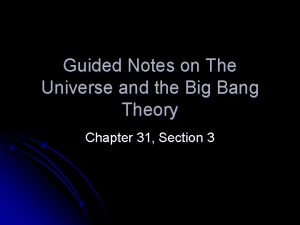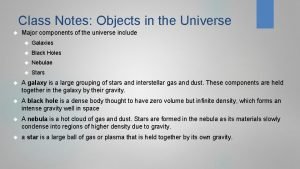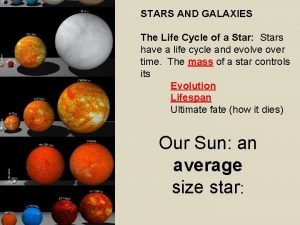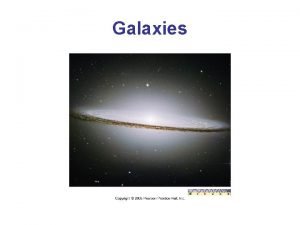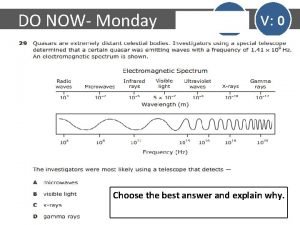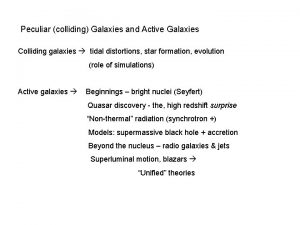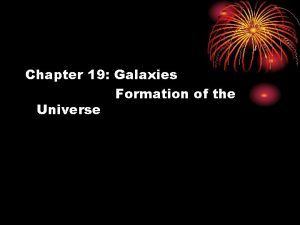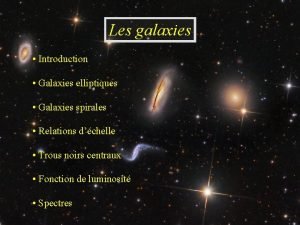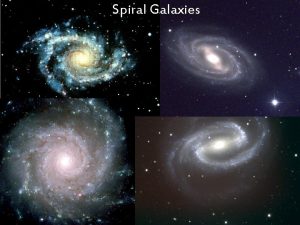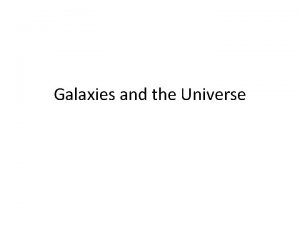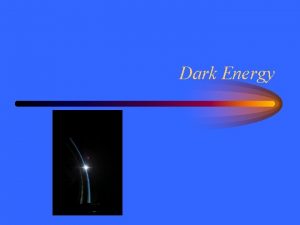Chapter 30 Notes Galaxies and the Universe The












- Slides: 12

Chapter 30 Notes Galaxies and the Universe

The Milky Way Galaxy • It is difficult to see the size and shape of the Milky Way from our perspective (inside it) • Every star we can see is part of the Milky Way

Milky Way: Size and Shape • Variable stars in globular clusters help to determine the size and shape of the galaxy • From the side, it looks something like a fried egg

Milky Way Galaxy: Spiral Arms • 4 major arms, several minor arms • About 100 billion stars in the disk • Galaxy halo: older, dimmer stars • Center: supermassive black hole

Population I and II Stars • Population I: Younger stars like the Sun found mostly in the disk and spiral arms; about 2% heavy elements • Population II: Older stars found in the halo or nuclear bulge; minimal amounts of elements heavier than helium

The Milky Way Galaxy • The spiral arms do not rotate as a unit • Spiral density wave hypothesis: traffic jam analogy

Other Galaxies • First one (Andromeda) discovered in 1924 by Edwin Hubble • Mass of other galaxies is dominated by mysterious subatomic particles called dark matter • The Milky Way is part of a group of about 40 other galaxies: the Local Group

Types of Galaxies • Hubble’s “tuning fork” diagram

The Expanding Universe • Another discovery by Hubble (1929) made by measuring the “redshift” of galaxies: – All distant galaxies are moving away from Earth – The farther away a galaxy is, the faster it is moving away – The entire universe is expanding • Extrapolating backward: at one time, all matter in the universe was compressed together

The Big Bang • Not an explosion—an expansion of the universe from a single point called the singularity • Further evidence: “fossil” radiation (cosmic background radiation)

Possibilities for the Future of the Universe • Flat: The expansion of the universe will slow down and stop • Closed: The universe will begin to contract • Open: The universe will continue to expand forever

Dark Energy/Dark Matter • Dark matter accounts for a large proportion of the mass of the universe • Astronomers estimate the amount of dark energy based on rate of expansion
 Chapter 30 galaxies and the universe
Chapter 30 galaxies and the universe Guided notes on the universe and big bang theory
Guided notes on the universe and big bang theory The electromagnetic spectrum includes
The electromagnetic spectrum includes Elliptical spiral and irregular
Elliptical spiral and irregular Components of the universe notes
Components of the universe notes Life cycle of a galaxy
Life cycle of a galaxy Elliptical galaxies facts
Elliptical galaxies facts Th eirregulars
Th eirregulars The pity relation for an adiabatic expansion is
The pity relation for an adiabatic expansion is Most galaxies in the inner region of a large cluster are
Most galaxies in the inner region of a large cluster are What are galaxies
What are galaxies Brainpop galaxies quiz answers
Brainpop galaxies quiz answers 4 types of galaxies
4 types of galaxies

